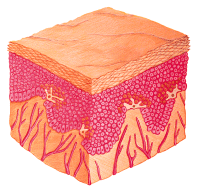Modern medicine uses liquid skin to reconstruct burnt epidermis
A breakthrough in treating deep and extensive thermal injuries took place in the beginning of the 1980s

Man-caused catastrophes and fires that accompany them will always generate work for doctors, who try to save the lives of those, who suffered from fire. That is why modern medicine is trying to create live biological materials, which could be capable of replacing the burnt parts of human skin. Russian scientists suggest several unique developments, which do not have any analogues in the world. 
Human skin is not only a border between the body and the environment. It is a very complicated multilayer organ. Autodermoplastics is considered a traditional method of treating patient's burnt skin. Doctors cut a layer of skin from the healthy part of a patient's body, stretch the piece of skin to the maximum and put it on the thermal injury. The method can not be used in case of extensive burning wounds, as it is impossible to take healthy skin from a patient.
A breakthrough in treating deep and extensive thermal injuries took place in the beginning of the 1980s. American biologist Howard Green conceived a method of growing skin patches from skin cells called keratinocytes, which populate the upper layer of skin. The cells were taken from patients. Transparent pieces, which could hardly be seen in the special nutritious liquid, were capable of saving people, who had up to 80 percent of their skin burnt. The technique, however, proved to be rather subtle and very expensive.
Russian scientists from the Institute of Surgery developed a method to grow donor fibroblast cells from the lower skin layer. Applying such patches on the burnt skin made it possible to save people's lives, although the cosmetic result of the method was slightly worse. The technique, however, allowed to set up the bank of transplants, which could be delivered to the site of mass thermal injuries.
Scientists from the Institute of Cytology of the Russian Academy of Sciences and the Institute of the Biology of Development elaborated a technology of growing both autologous and donor keratinocytes. Layers of epidermis grown from donor cells played the role of high-quality bondage. The layers would come off afterwards, leaving healthy reconstructed skin on the patient's body. Biologists determined that donor layers powerfully stimulated the healing process of the burn wounds.
Specialists of the cell technology laboratory of the Institute of Biology of Development put forward a completely new medical method several years ago. Professor Andrey Vasiliev said that a group of specialists from the laboratory declined the method of growing keratinocytes at the end of the 1980s. “Special containers, enzymes, the nutritious fluid – they were very expensive, imported things. The cells turned out to be rather willful – they were very sensitive to every slightest mistake. The fact brought up the idea of growing cells on micro-carriers – collagen balls 200-300 micron in diameter,” the professor said.
As it often happens in Russia, the bright idea came out of poverty. Biologists started growing epidermis cells on collagen balls. They received the substance, which could be literally poured onto a burn wound and then spread like butter. Cells start “migrating” from collagen balls to the wounded surface, which served as a nutrient medium for them. It became possible to grow fibroblasts and keratinocytes separately, to blend and transplant them together. All the cells find their places on a wound and form the normal epidermis. Furthermore, it turned out that it was possible to grow such cells, place them in a special liquid, freeze it and store it like donor blood. Russian scientists use the wastes of plastic surgery for growing skin cells.
The technique laid the foundation of the new invention – the collagen gel. The gel gives a powerful incentive to the healing process when it is applied on a burn wound. When specialists added keratinocytes to the gel, they received the live equivalent of the multilayer human skin. Clinic trials conducted by specialists of Russia's Sklifosovsky Institute revealed that the two equivalents could heal extensive and deep burns rather effectively.
Furthermore, the gel can be used to heal up the wounds that require a protracted course of therapy.
Eye burns are one of the most complicated problems of ophthalmology. Acid or alkali on cornea develops an ulcer, which could be treated with the following two methods. Doctors either put bondage on eyes for 12 months, or transplanted the cornea of a corpse. Furthermore, it is very hard to transplant cells in the eyes: eyes never stop moving, tears keep their surface moist. Doctors transplant the live dermal equivalent on the inner surface of soft contacts. If an individual has a fresh eye burn, it is possible to keep the eye alive along with the eyesight.
The original idea with liquid skin has generated several technologies already. In addition, specialists are pondering over new ways of its usage.
Tatiana Bateneva
Subscribe to Pravda.Ru Telegram channel, Facebook, RSS!


